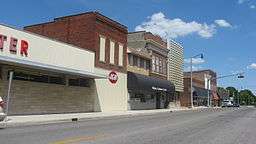Oblong, Illinois
| Oblong | |
| Village | |
 West Main Street downtown | |
| Country | United States |
|---|---|
| State | Illinois |
| County | Crawford |
| Coordinates | 39°0′5″N 87°54′30″W / 39.00139°N 87.90833°WCoordinates: 39°0′5″N 87°54′30″W / 39.00139°N 87.90833°W |
| Area | 0.97 sq mi (3 km2) |
| - land | 0.96 sq mi (2 km2) |
| - water | 0.01 sq mi (0 km2) |
| Population | 1,466[1] (2010) |
| Density | 586.4 / km2 (1,519 / sq mi) |
| Mayor | Randy Rich |
| Postal code | 62449 |
| Area code | 618 |
  Location of Oblong within Illinois
| |
| Wikimedia Commons: Oblong, Illinois | |
Oblong is a village in Crawford County, Illinois, United States. The population was 1,466 at the 2010 census. The village says that it is "The Only Oblong" in the world. It is the home of the Illinois Oil Field Museum and Resource Center at Oblong, Illinois, a collection of early oilfield artifacts from the early days of the oil industry in the Illinois Basin and a resource center featuring a collection of early oil field records and resource books. Oblong also hosts one of Illinois's largest night time parades. Along with the night time parade, a band competition called "Spooktacular" is hosted annually the last week in October.
Oblong has one public four year high school and one public grade school.
History
Oblong was incorporated in 1883.[2] The village was originally a crossroads, notable only for its general store, owned by Henry Peck. The store featured a prominent sign, "Hen. Peck" and people of the area referred to the crossroads as "Henpeck." When the village decided to incorporate, it was decided that Henpeck would be an unsuitable name, and it was named after a rectangular prairie on the outskirts of the community.
Geography
Oblong is located at 39°0′5″N 87°54′30″W / 39.00139°N 87.90833°W (39.001274, -87.908470).[3]
According to the 2010 census, Oblong has a total area of 0.978 square miles (2.53 km2), of which 0.97 square miles (2.51 km2) (or 99.18%) is land and 0.008 square miles (0.02 km2) (or 0.82%) is water.[4]
Demographics
| Historical population | |||
|---|---|---|---|
| Census | Pop. | %± | |
| 1890 | 390 | — | |
| 1900 | 743 | 90.5% | |
| 1910 | 1,482 | 99.5% | |
| 1920 | 1,547 | 4.4% | |
| 1930 | 1,427 | −7.8% | |
| 1940 | 1,547 | 8.4% | |
| 1950 | 1,639 | 5.9% | |
| 1960 | 1,817 | 10.9% | |
| 1970 | 1,860 | 2.4% | |
| 1980 | 1,840 | −1.1% | |
| 1990 | 1,616 | −12.2% | |
| 2000 | 1,580 | −2.2% | |
| 2010 | 1,466 | −7.2% | |
| Est. 2014 | 1,426 | [5] | −2.7% |
As of the census[7] of 2000, there were 1,580 people, 681 households, and 439 families residing in the village. The population density was 1,662.8 people per square mile (642.1/km²). There were 761 housing units at an average density of 800.9 per square mile (309.3/km²). The racial makeup of the village was 98.92% White, 0.19% African American, 0.25% Native American, 0.13% Asian, and 0.51% from two or more races. Hispanic or Latino of any race were 0.57% of the population. (There are 2 to 8 people of each of the minorities listed; one person constitutes about 0.063% of the 1,580 population.) Oblong is mentioned by James Loewen[8] as a sundown town.
There were 681 households out of which 27.6% had children under the age of 18 living with them, 48.9% were married couples living together, 12.3% had a female householder with no husband present, and 35.4% were non-families. 32.3% of all households were made up of individuals and 18.5% had someone living alone who was 65 years of age or older. The average household size was 2.25 and the average family size was 2.81.
In the village the population was spread out with 22.8% under the age of 18, 7.7% from 18 to 24, 24.9% from 25 to 44, 20.8% from 45 to 64, and 23.9% who were 65 years of age or older. The median age was 41 years. For every 100 females there were 81.2 males. For every 100 females age 18 and over, there were 80.5 males.
The median income for a household in the village was $27,409, and the median income for a family was $36,532. Males had a median income of $27,135 versus $20,560 for females. The per capita income for the village was $14,926. About 7.0% of families and 9.9% of the population were below the poverty line, including 15.0% of those under age 18 and 5.6% of those age 65 or over.
References
- ↑ http://www.citypopulation.de/php/usa-census-illinois.php
- ↑ Columbia-Lippincott Gazeteer. 1952 Edition, p. 1362
- ↑ "US Gazetteer files: 2010, 2000, and 1990". United States Census Bureau. 2011-02-12. Retrieved 2011-04-23.
- ↑ "G001 - Geographic Identifiers - 2010 Census Summary File 1". United States Census Bureau. Retrieved 2015-12-25.
- ↑ "Annual Estimates of the Resident Population for Incorporated Places: April 1, 2010 to July 1, 2014". Retrieved June 4, 2015.
- ↑ "Census of Population and Housing". Census.gov. Retrieved June 4, 2015.
- ↑ "American FactFinder". United States Census Bureau. Retrieved 2008-01-31.
- ↑ Loewen, James W. (2005). Sundown Towns: A Hidden Dimension of American Racism. New Press. ISBN 1-56584-887-X.
External links
| |||||||||||||||||||||||||||||||||||||||||